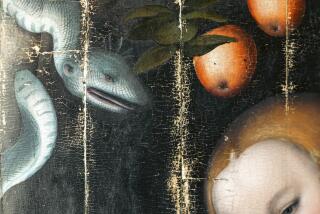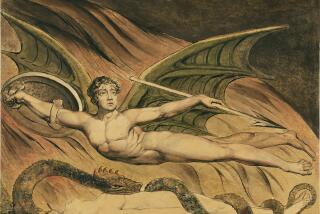Getty Villa’s ‘Heaven and Earth’ a blockbuster show of Byzantium art
When the great Irish poet William Butler Yeats prayed for some kind of connection to permanence and immortality, his thoughts turned to Byzantine art as the most perfect emblem of the profound, eternal state of creative grace he was after.
He wrote, in “Sailing to Byzantium,” of a yearning to encounter and be transformed by the gold-infused religious images of “sages standing in God’s holy fire” that define the Byzantine style.
Now Byzantium is sailing to Los Angeles. “Heaven and Earth: Art of Byzantium from Greek Collections,” the biggest Byzantine art blockbuster to reach the West Coast, begins a 41/2-month run at the Getty Villa on April 9, along with a smaller related show of illuminated manuscripts at the Getty Center in Brentwood that runs for three months starting March 25.
CHEATSHEET: Spring 2014 arts preview
Whether the 178 works to be on display at the Villa will induce Yeatsian mystical transports is uncertain, but they promise to be an eyeful. The show includes many painted icons or mosaics of figures enveloped in the golden glow that elicited that “God’s holy fire” metaphor from the poet.
It’s drawn from 34 national collections in Greece and spans more than 1,300 years. The starting point goes back even before the reign of the Roman Emperor Constantine, who decreed Christianity the official state religion and in AD 330 relocated its imperial capital from Rome to the site in present-day Turkey that he named Constantinople.
People in the Byzantine Empire spoke Greek and referred to themselves as “Romans”; the name “Byzantium” — for the capital and the empire it anchored — came into use only later, inspired by Byzantion, the name of the settlement that Greek colonists had established around 500 BC at the future Constantinople.
The dwindling Byzantine empire fell — and the show ends — in 1453, when conquering Ottoman Turks gave the capital its present name, Istanbul.
If Byzantium’s artistic signature is the enduring holy aura that Yeats celebrated, the exhibition seeks to explore how art and life were in fact buffeted and changed by historic upheavals over the millennium-plus it surveys.
CRITICS’ PICKS: What to watch, where to go, what to eat
“It’s a rather old trope that Byzantine art looks the same, but it doesn’t,” said Mary Louise Hart, a Getty curator of antiquities who’s overseeing the exhibition at the Villa. “It’s a goal of this exhibition to communicate their great diversity of artistic expression over this amount of time.”
The show will illustrate how pagan beliefs and their artistic embodiments gave way to Christian ones but continued to exert an influence well into the Christian period.
Perhaps the biggest upheaval of all isn’t represented because it can be marked only by a void: Byzantine art went blank for most of the 117-year period from 726 to 843. The culture that had hatched one now-overused word, “icon,” gave birth to another, “iconoclast,” when religious and imperial authorities enforced an Old Testament prohibition against making “graven images” of living beings.
With considerable success, the iconoclasts set about expunging religiously venerated paintings and images depicting Jesus, Mary and the saints — known as icons in the Eastern Orthodox church.
Another big upheaval came in the 1200s, when Crusaders from France and Venice temporarily ousted the Byzantine rulers for nearly 60 years. The exhibition shows how western European influences seeped into Byzantine art, and how artistic influence also moved in the other direction as Byzantine styles informed early Renaissance painting in Italy.
The show has only three works by artists whose names are known: Andreas Pavia and Andreas Ritzos, who emerged at the end of the Byzantine era. Before then, said Hart, the icon painters were mainly monks who, unlike the more individualistic Italians, considered their work a manifestation of faith rather than an assertion of self.
PHOTOS: The most fascinating arts stories of 2013
The show that will educate Angelenos about all that conflict and what it meant for the creation of art was made possible by the end of more than a decade of contention between the Getty Trust and Greek cultural authorities. Relations had reached a low in the mid-2000s when Greece charged Marion True, the L.A. museum’s longtime chief antiquities curator, with receiving stolen property in the Getty’s 1990s acquisition of an ancient funerary wreath.
True eventually resigned from the Getty, for reasons not directly related to the disputed wreath. The charge against her in Greece was dropped, and the museum returned the wreath and several other previously contested items to Greece.
The hatchet was officially buried in a September 2011 accord in which the Getty and the Greek Ministry of Culture agreed to forge a new “framework of cooperation.” The first and very substantial fruit is “Heaven and Earth,” whose previous U.S. stop starting last fall was at the National Gallery of Art in Washington, D.C., where officials say it was seen by more than 1,400 visitors a day, making it one of the dozen or so most popular exhibitions of the past five years.
Until now the Metropolitan Museum of Art in New York City had held a monopoly on Byzantine art blockbusters in the U.S. It had covered the millennium-plus of art history under review at the Getty in three shows over 27 years, the first in 1977 and the last in 2004.
The Met’s approach — and that of a big Byzantine art show in 2008-09 at the Royal Academy of Art in London — involved borrowing works from many countries, in recognition that the Byzantine Empire at its peak had wide-ranging borders, including present-day Turkey, Egypt, Italy, North Africa and Balkan nations besides Greece, and had heavily influenced Russia.
ART: Can you guess the high price?
But Greece was at the heart of the Byzantine empire and can supply a show on its own. Moreover, nowadays art loans from Turkey and Russia to museums in the United States are all but impossible, because of 21st century cultural politics. Turkish cultural authorities are unhappy about allegedly looted antiquities harbored in the U.S., while the Russians have imposed an embargo on art loans since 2011 after a judgment in a lawsuit over a prized collection of Jewish books.
Hart said that Greek curators structured the show and that she and Susan Arensberg of the National Gallery of Art spent two weeks in Greece in 2012 discussing which of the more than 300 offered objects should make the trip.
One that Hart requested to show how Byzantium dealt with the pagan world is a head of Aphrodite, the Greek goddess of love, hewn before AD 100 and copied from a famous bust created about 400 years earlier by the great Athenian sculptor, Praxiteles. The early Greek Christians made the marble pagan love goddess their own by carving a cross into its forehead.
“The idea was to repurpose it,” she said. “It may have operated as the head of a Virgin Mary.” The old and new faiths were interwoven early on, she said — as illustrated by a find from a single household on the Greek island of Lesbos that includes a pot with a carving of Aphrodite on the handle, and a plate decorated with a cross.
“It’s not like one day you’re worshiping Venus and the next you’re worshipping the Virgin Mary,” she said. There was a transition, and the ancient Greek and Roman traditions kept their cachet even after the pagan religious beliefs had died out.
PHOTOS: Faces to watch 2014 | Art
A section of the show that deals with the intellectual life of Byzantium includes manuscript pages from “The Iliad” of Homer and ancient plays of Sophocles and Aeschylus that were created in the Christian period as well as depictions of Alexander the Great.
A distinctive thing about “Heaven and Earth,” says Hart, is the “Earth” part. While giving due attention to Byzantium’s definitive religious art, the exhibition also aims to show that affluent Byzantine Greeks knew how to kick back and enjoy themselves.
The Greek cultural authorities who organized the exhibition “wanted to make sure it wasn’t just about emperors and priests,” Hart said. They included a section on “The Pleasures of Life,” a tour through some of the blingy things that make living fun: gold rings, jeweled earrings and fancy plateware.
The humblest pieces in the exhibition are five two-pronged bronze forks that are 900 to 1,000 years old, coming to show Angelenos that our daily habit of using similar utensils to convey food from plate to mouth began around Byzantine tables.
According to Hart, Byzantine cuisine was served hot and slathered in sauce, making it unmanageable with bare hands. And if the long, billowing sleeves on Byzantine robes were to be saved from the sauce, some sort of extension of the fingers was needed. Big forks had existed previously for moving and carving hunks of meat; the Byzantine contribution was scaling them down for scarfing.
With the religious icons, Hart said, the challenge for the Getty has been how to evoke the “God’s holy fire” effect that knocked out William Butler Yeats.
The glow from the gold leaf stamped into the images had maximum impact, she said, because “the icons were destined to be hung in dark, interior spaces lit by candles, which gave them a much more glittering and otherworldly effect.”
Candles won’t do in a museum, so the Getty will try to deploy some artistry of its own. “In our largest gallery with the icons and liturgical vessels we have everything painted this lustrous, deep, rich jewel-toned red to evoke one of the most popular hues of that era,” Hart said. “It will be dark in there, and it has to be to preserve the icons. Our lighting is obviously not candlelight. We won’t have that magic, but we’ll do our best.”
More to Read
The biggest entertainment stories
Get our big stories about Hollywood, film, television, music, arts, culture and more right in your inbox as soon as they publish.
You may occasionally receive promotional content from the Los Angeles Times.











